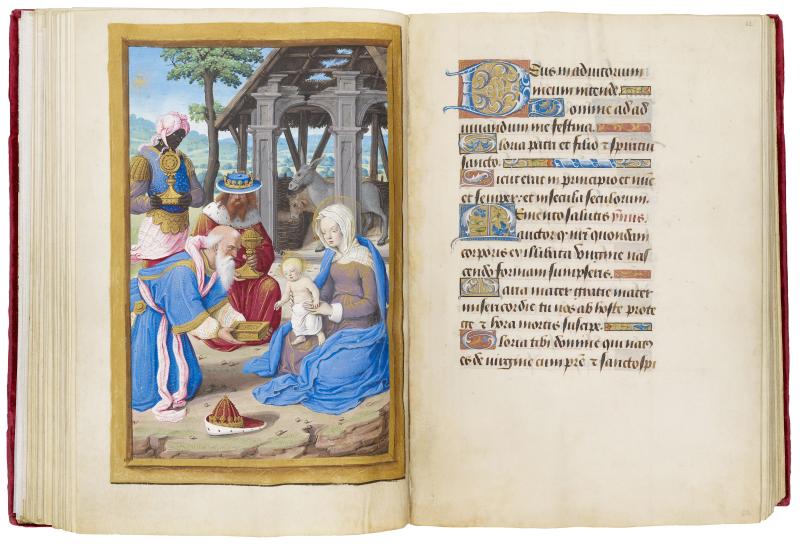
Sext: Adoration of the Magi
Hours of Henry VIII
Illuminated by Jean Poyer
Gift of the Heineman Foundation, 1977
Sext: Adoration of the Magi (fol. 61v)
In Poyer's Adoration, the Virgin, in an act of humility, sits on the ground as each of the Magi presents his gift to the child standing on her lap. The innate nobility of the Magus is achieved by some of Poyer's most inspired painting, especially evident in his closely observed facial features, gold earring, and exotic turban.
Caspar, the name supplied for the oldest Magus, has removed his crown in deference to Christ as King, kneels and presents gold; the second, holding a chalice with incense, waits his turn; while the youngest, still at a distance, stands erect and holds a monstrance.
Poyer designed his compositions like stage sets: the ruinous stone arches of the stable will reappear in the Massacre of the Innocents (cf. folio 69v), and the ox and ass eat hay from the wattled manger that previously served as Christ's cradle.
In the later Middle Ages, when the Magi were connected with the three continents known then (Europe, Africa, Asia), Balthazar was increasingly depicted as a black man. In some late- fifteenth-century paintings, however, as here, it was the youngest Magus who was so depicted.
Adoration of the Magi
According to the Gospel of Matthew (2:1–12), wise men from the East who saw the star signifying the birth of the King of the Jews went to adore him at Jerusalem, only to discover that he was born in Bethlehem (fulfilling the prophecy of Micheas 5:2). Since the wise men offered three gifts—gold, frankincense, and myrrh—it was assumed as early as the third century that they were three; about the same time they were redefined as kings, and by the ninth century they were supplied with the familiar names of Caspar (the oldest), Balthazar, and Melchior (the youngest). In the later Middle Ages, when the Magi were connected with the three continents known then (Europe, Africa, Asia), Balthazar was increasingly depicted as a black man. Their gifts were also given various explanations. According to St. Bernard of Clairvaux (1090–1153), the gold gave testimony to the Virgin's poverty, the incense purified the smell of the stable, and myrrh strengthened the child's limbs (driving out the worms from his entrails). For the Venerable Bede (672/73–735) they signified the royalty, divinity, and humanity of Christ: gold for royal tribute to the highest king; incense for divine worship since he was God; and myrrh for burial, foreshadowing his own death, since he was a mortal man. These explanations were popularized in printed editions of the Golden Legend (compiled by Jacobus de Voragine before 1267).
